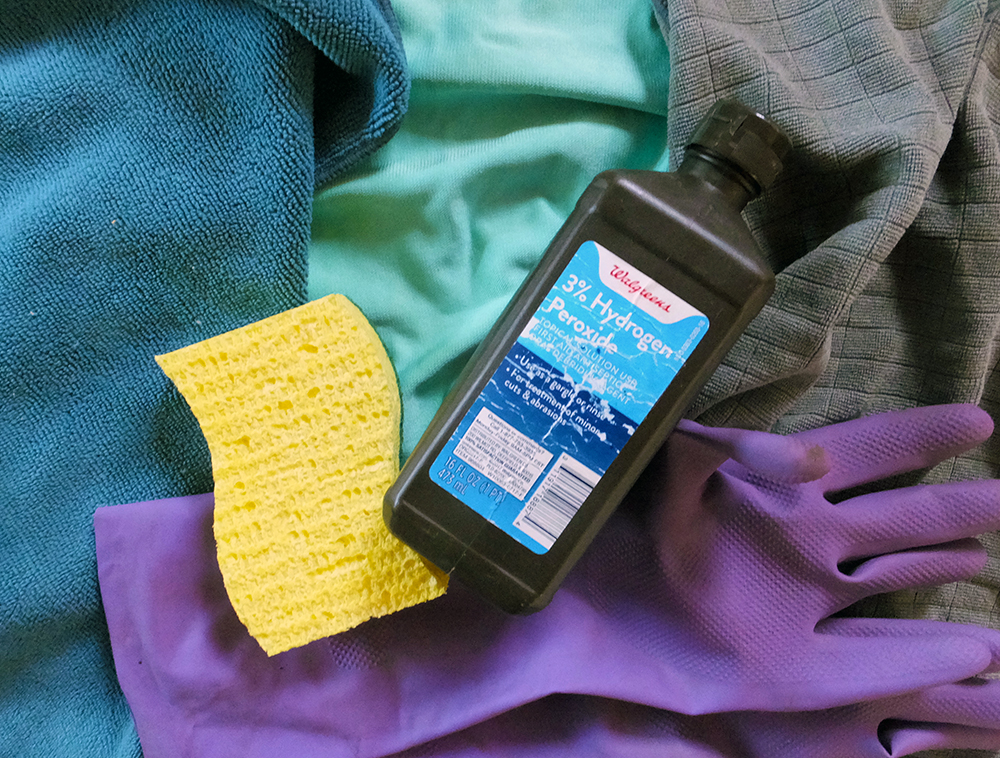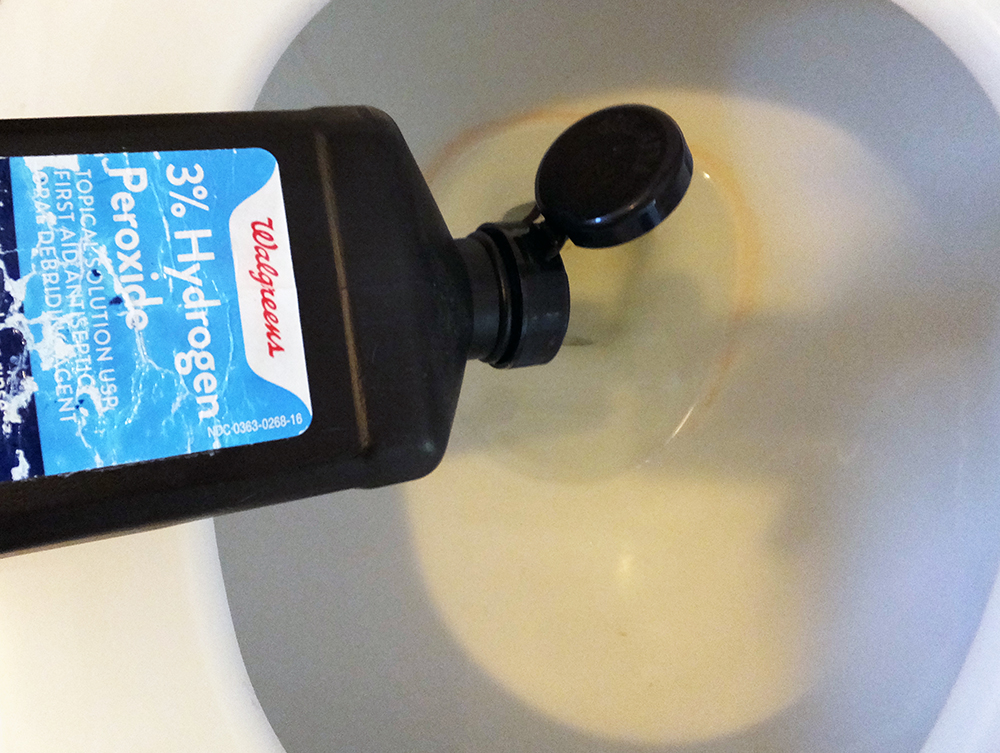What you should know about cleaning with hydrogen peroxide

Hydrogen peroxide is available at nearly all drug stores, pharmacies and big box stores. Held in opaque bottles, it has made its way into almost every medicine cabinet and first aid kit. But it’s more than just a solution for cleaning wounds. It’s also versatile and fairly safe to use.
Hydrogen peroxide is a chemical compound with molecules that contain two hydrogen atoms bonded with two oxygen atoms. Hydrogen peroxide oxidizes compounds that are common in organic life, which disinfects surfaces. It dissolves proteins by breaking apart and releasing water and oxygen-free radicals. When the water and oxygen are released, it creates a fizzy foam.
The clear liquid comes in various potencies, depending on what you intended to use it for. Three percent solutions are most commonly used as a household cleaner, but there are also six to 10 percent solutions for hair bleaching, 35 percent solutions for food-grade cleaning and 90 percent solutions for industrial use.
Besides being antifungal and antibacterial, hydrogen peroxide is non-toxic and does not irritate lungs. Plus, it is multipurpose, so you can get a lot out of a single bottle.
Keep in mind, though: hydrogen peroxide loses its effectiveness when exposed to air or sunlight. Unlike many homemade cleaners can be made in advance, hydrogen peroxide solutions generally cannot be made before using them.
Also, do not mix hydrogen peroxide and vinegar together. Combining the two will form peracetic acid, which could irritate your skin, eyes and respiratory system. In serious cases, peracetic acid can even cause permanent lung damage.
Here is what you should know about cleaning with hydrogen peroxide, and the ways that you can do so.
Cleaning with hydrogen peroxide in the kitchen
Spray hydrogen peroxide directly into your dishwasher, let it sit for a few minutes and wipe it out to disinfect this kitchen appliance. You can create a sweet-scented dishwasher cleaning “bomb” with hydrogen peroxide, baking soda and essential oil. Mix the materials into a chalky paste and use an ice cream scoop to form round balls. Let them dry overnight. Then, place a bomb on the bottom rack of the dishwasher. Mix white vinegar and liquid dishwashing detergent in a glass or ceramic bowl and place it in the top rack. Run through a hot cycle for a sparkling, fresh dishwasher.
You can also use hydrogen peroxide to disinfect your refrigerator. After a scrubbing for food scraps and residue, spray the inside or your refrigerator with hydrogen peroxide to kill any lingering bacteria. Let it sit for several minutes and then wipe down with a wet cloth.
If your favorite pan or baking sheet is afflicted with baked-on grease, rub with a paste of hydrogen peroxide and baking soda. Let it sit for a while, then use a scrubby sponge and warm water to lift the stains right off.
Cutting boards and sponges are some of the dirtiest items in your kitchen. You can repurpose old cutting boards and sponges, but until then, make sure they are as sanitary as possible by cleaning them will hydrogen peroxide. Add hydrogen peroxide to an opaque spray bottle (remember, exposure to light will nix its effectiveness) and spray on cutting surfaces. Let bubble for a few minutes, then scrub and rinse clean with water. Soak sponges for ten minutes in a half-and-half mixture of hydrogen peroxide and warm water in a shallow dish. Rinse the sponge thoroughly afterward.
Cleaning with hydrogen peroxide in the bathroom

Hydrogen peroxide is great for removing stubborn mold, mildew and mysterious crust on surfaces throughout your house. Fill an opaque spray bottle and go nuts on your bathroom fixtures, floors and walls. It is especially useful on mildewy shower curtains. Once the solution has had a chance to bubble and set, scrub any lingering mildew or mold with a rag or sponge.
Hydrogen peroxide can also be used to clean your toilet bowl. Pour half a cup of hydrogen peroxide into the toilet bowl, let stand for 20 minutes, then scrub clean.
Spray hydrogen peroxide onto mirrors or glass surfaces and wipe with a microfiber cloth or crumpled newspaper for a streak-free, mildew-free shine.
Hydrogen peroxide is great at whitening and brightening stained tiles and dirty grout. Combine half a cup of hydrogen peroxide with one gallon of hot water, then go to town on your flooring. Because it’s so mild, it’s safe for any floor type, and there’s no need to rinse. For grout, either pour the hydrogen peroxide straight onto the tile or make a paste with baking soda and scrub away.
Though your toothbrush should be replaced every three months, in the meantime, kill nasty germs on your toothbrush by soaking it in hydrogen peroxide. A 2011 study published in Contemporary Clinical Dentistry found that this is more effective than rinsing the toothbrush with water. Hydrogen peroxide works for retainers and mouth guards, too.
Each time you use tweezers, manicure or pedicure tools, and eyelash curlers they come in contact with body soil and bacteria. A dip or rub-down with a bit of hydrogen peroxide will sanitize the tools and prevent infections.
Cleaning marble with hydrogen peroxide
Marble is one of the trickier surfaces to clean. Unsealed marble is prone to staining (even water can stain it). Address stains as soon as you notice them: make a paste of flour and hydrogen peroxide and apply it directly to the stained surface. Cover the area with plastic wrap to keep the paste from drying out, and let it sit overnight. Wipe up the paste in the morning with a damp cloth and the stain should be gone, or at least greatly lightened. Repeat the process, if needed.
Sealed marble is also best cleaned with hydrogen peroxide and a few drops of ammonia (be very sparing — too much will cause damage to the surface).
A warning, though: hydrogen peroxide can bleach darker marble, so save this handy hack for light surfaces only.
Cleaning laundry with hydrogen peroxide
Believe it or not, commercial laundry products that have “oxy” in the name are often referring to the presence of hydrogen peroxide.
Hydrogen peroxide can be used as a pre-treater for stains — just soak the stain for a little while with hydrogen peroxide before tossing into the laundry.
This is especially useful for blood (I’m looking at all your backyard chicken processors out there). Apply full-strength hydrogen peroxide directly to a bloodstain as soon as possible, and let it sit until it stops fizzing. Then, dab at the stain with a clean cloth to lift it. Repeat the process until the stain is gone, and then launder the garment like you normally would.
You can also erase embarrassing brown and yellow armpit stains on your favorite t-shirts with a solution of one part dishwashing liquid and two parts hydrogen peroxide, then applying it to the stain for about an hour. Wash in cold water, then dry and wear. Note: A tough stain may also require scrubbing with baking soda. (If your t-shirt is beyond repair, here are some ways you can give it new life.)
You can also add a cup of peroxide to a regular load of whites to boost their brightness as a more environmentally-friendly alternative to bleach. Do not use hydrogen peroxide on colored clothing, though, because it is not color-safe.
If your towels have become a little musty smelling, add one cup hydrogen peroxide, let soak for an hour and run through the washer as usual to get rid of the smell (though save this laundry hack for light-colored towels if you are averse to unsightly bleaching). This also works for foul-smelling athletic equipment or farm clothes.
Cleaning kids’ and pets’ toys and play areas
Hydrogen peroxide is a safe cleaner to use around kids, or anyone with respiratory problems because it’s not a lung irritant. Fill an opaque spray bottle with hydrogen peroxide and spray toys, toy boxes, doorknobs and anything else your kids touch on a regular basis to keep germs at bay. You could also soak a rag in peroxide and wipe these surfaces down.
Kids’ lunchboxes are another oft-overlooked area that can benefit from cleaning with hydrogen peroxide. Spray lunchboxes with hydrogen peroxide at the end of the week. Let it sit for a few minutes before rinsing with clean water and wiping it down.
If you want to clean your pet’s nasty chew toys without poisoning them, use and half-and-half solution of water and hydrogen peroxide and soak the toys. Remove when the liquid stops bubbling, rinse thoroughly with water and let dry.
Hydrogen peroxide is also effective to control fungi in fish tanks. It won’t hurt your fish but use it sparingly for this purpose as it can toxically elevate tank oxygen levels.
Reusable grocery bags
Reusable grocery bags — even the plastic-lined ones — should be scrubbed regularly with soap and hot water, then left to air dry. If you don’t have time for a thorough cleaning, give the interior a quick spray with hydrogen peroxide to kill harmful bacteria before you head off on your next grocery shopping or farmers market trip.
Cleaning humidifiers and dehumidifiers with hydrogen peroxide
Dehumidifiers and humidifiers are breeding grounds for mold due to the moisture and heat they collect or generate. Keep them clean by running a solution of half water and half hydrogen peroxide through them monthly.
In general, what you most need to know about cleaning with hydrogen peroxide is that if you are looking for a safer, cheaper way to clean your house, hydrogen peroxide may be a great tool for you.
Do you have any experience cleaning with hydrogen peroxide? Let us know in the comments below.

Wow.. Never knew hydrogen peroxide can be used to clean a whole lot of things in the home.
I will definitely add it to my cleaning agents for my home routine cleaning.
This is great info, though a moot point seeing as in addition to the rubbing alcohol totally out in all the stores around me, the H2O2 is also non existent. I will bookmark this for the time I can actually obtain these ingredients.
Thanks so much for all the information on this! I am immunosuppressed due to a medical condition and I am required to be extra careful regarding being around germs because I have very low white blood cell count and low red blood cell count and my body just can’t fight things off like a normal person. With the COVID 19 going on I cannot find any hand sanitizer which I regularly use and of course I happened to run out right as this COVID 19 was just getting started along with my hand sanitizer wipes and Lysol wipes which are very necessary in my day to day life and not just due to this outbreak. It is very sad bc for people like me that really require these necessities to survive day to day, people are going overboard and stockpiling these items and depriving people with health conditions that require these items for normal day to day survival. We rely on things like these for day to day and not just for emergency situations like COVID 19 so it is really helpful to know that there is an alternative that I can use. I was trying to use vinegar because that is all I could find in the stores locally (or anywhere, really!) ? but we have several bottles of hydrogen peroxide that I bought us for first aid kits for myself and my mom and grandmother last year so between the 3 of us we can hopefully have enough to disinfect and sanitize for me to make it through this shortage. I appreciate your knowledge. Keep doing what you do girl! You rock!